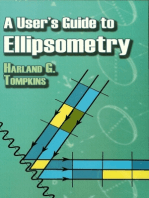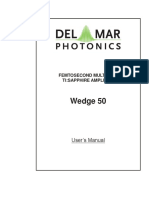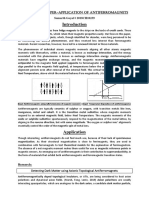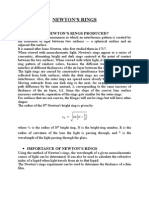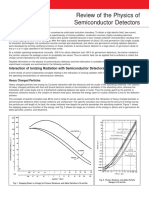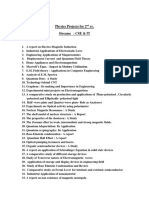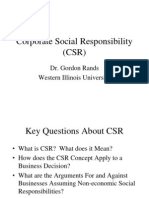A Short Introduction To Free Electron Lasers: The Cern Accelerator School
A Short Introduction To Free Electron Lasers: The Cern Accelerator School
Uploaded by
Horenhop DolakovCopyright:
Available Formats
A Short Introduction To Free Electron Lasers: The Cern Accelerator School
A Short Introduction To Free Electron Lasers: The Cern Accelerator School
Uploaded by
Horenhop DolakovOriginal Description:
Original Title
Copyright
Available Formats
Share this document
Did you find this document useful?
Is this content inappropriate?
Copyright:
Available Formats
A Short Introduction To Free Electron Lasers: The Cern Accelerator School
A Short Introduction To Free Electron Lasers: The Cern Accelerator School
Uploaded by
Horenhop DolakovCopyright:
Available Formats
THE CERN ACCELERATOR SCHOOL
A Short Introduction to Free Electron Lasers
Andy Wolski
The Cockcroft Institute, and the University of Liverpool, UK
CAS General Accelerator Physics
Granada, Spain, November 2012
Free Electron Lasers
Free electron lasers (FELs) are sources of synchrotron
radiation that can produce radiation with peak power and
brightness orders of magnitude larger than the radiation
produced by conventional sources such as dipoles and wigglers.
In this lecture, we shall:
consider ways to enhance the intensity of radiation from
undulators (developing the principles behind FELs);
discuss some of the dierent types of free electron laser.
CAS, Granada, 2012 1 Free Electron Lasers
Radiation from an Oscillating Electric Charge
Consider a single oscillating electron. The amplitude of the
electric and magnetic elds in the radiation produced by the
electron are proportional to the charge on the electron.
The total radiation power from a Hertzian dipole is:
P =
ck
4
l
2
q
2
12
0
. (1)
We might expect the radiation power from an undulator to
increase with the square of the bunch charge: but in practice,
the power increases linearly with the charge. Why?
CAS, Granada, 2012 2 Free Electron Lasers
Synchrotron Radiation from an Undulator
Recall that synchrotron radiation is produced from an
undulator by the oscillations induced on electrons passing
through the undulator.
CAS, Granada, 2012 3 Free Electron Lasers
Incoherent Radiation from an Undulator
Consider a bunch of ultra-relativistic electrons with relativistic
factor , passing through an undulator. In the lab frame, the
bunch length is
z
, and the undulator period is
u
.
In the rest frame of the electrons, the bunch length is
z
, and
the undulator period is
u
/.
Typically,
z
is a few mm, and
u
is a few cm; but if is large:
z
u
2
. (2)
In other words, in the rest frame of the electrons, the bunch
length is much larger than the undulator period.
Therefore, in the rest frame of the electrons, the electrons are
oscillating at dierent (random) phases.
CAS, Granada, 2012 4 Free Electron Lasers
Incoherent Radiation from an Undulator
The total electric eld is the sum of the elds from all the
electrons:
E
total
=
N
n=1
E
0
e
i
n
, (3)
where E
0
is the eld due to a single electron, and
n
is the
phase of the electric eld from the n
th
electron.
Since the electrons are
oscillating at random phases,
summing the elds is equivalent
to a random walk in the
complex plane.
CAS, Granada, 2012 5 Free Electron Lasers
Incoherent Radiation
Since the radiation is produced from particles oscillating at
random phases, the generation is said to be incoherent.
In that case:
|E
total
|
NE
0
. (4)
For a large number of electrons N, the total eld strength is
proportional to the square root of the number of electrons.
Since the energy carried by an electromagnetic wave is
proportional to the square of the eld amplitude, the power of
incoherent synchrotron radiation from an undulator is
proportional to the current in the undulator.
CAS, Granada, 2012 6 Free Electron Lasers
Coherent Radiation
If all the electrons are oscillating in phase (or with phase
dierence strictly related to the distance between the
electrons), then the elds in the synchrotron radiation add
coherently. This situation can be represented by:
n
0
, (5)
where
0
is a constant. Then:
|E
total
| NE
0
. (6)
The total eld is proportional to the
number of electrons, and the
radiation power will be proportional to
the square of the number of electrons.
The radiation is emitted coherently.
This can occur if the bunch length is
less than the radiation wavelength.
CAS, Granada, 2012 7 Free Electron Lasers
Coherent Radiation from an Undulator
Since the number of electrons in a bunch can be very large, the
enhancement of radiation power from coherent emission
compared to incoherent emission is potentially dramatic.
Recall that an undulator produces radiation at a wavelength:
=
u
2
2
_
1 +
K
2
2
_
. (7)
The condition for coherent radiation can be written:
z
u
/
2
. (8)
This condition can be dicult to achieve; however, one eect
of the interaction between electrons and radiation with an
undulator can be the development of microbunches within a
beam.
If the size of each microbunch is less than a radiation
wavelength, then each microbunch can radiate coherently.
CAS, Granada, 2012 8 Free Electron Lasers
Coherent Radiation from an Undulator
Electrons in a bunch passing through an undulator can interact
with the radiation produced by other electrons within the
bunch. The forces on the electrons from the radiation eld
leads to a transfer of energy between the electrons and the
radiation.
In the low-gain regime, the radiation intensity can be
treated as approximately constant. There is some transfer
of energy between the electrons and the radiation, but the
main eect is a change in the motion of the electrons so
that microbunches start to develop, with length of order
of the radiation wavelength.
In the high-gain regime, the microbunching becomes strong
enough that coherent radiation gives a rapid increase in
radiation intensity. This in turn enhances the
microbunching: the result is a rapid exponential increase in
the radiation intensity with distance along the undulator.
CAS, Granada, 2012 9 Free Electron Lasers
Coherent Radiation from an Undulator
CAS, Granada, 2012 10 Free Electron Lasers
Types of FEL
FELs can be categorised according to how the microbunching
is achieved. For example:
In a resonator FEL, the incoherent radiation produced in an
undulator is trapped within an optical cavity. Each electron
bunch passing through the undulator adds to the radiation
intensity, which leads to an increase in the rate at which
microbunching takes place.
In a seeded amplier FEL, a radiation pulse (e.g. from a
laser) is co-propagated with an electron bunch in an
undulator. This initiates microbunching, which then
develops rapidly along the undulator as the electrons within
each microbunch radiate coherently.
A SASE (Self-Amplied Spontaneous Emission) FEL works
in a similar way to a seeded amplier, except that the initial
microbunching is initiated by the spontaneous radiation
within the undulator, rather than from an external seed.
CAS, Granada, 2012 11 Free Electron Lasers
Types of FEL
Each type of FEL has certain advantages and disadvantages,
and can be suitable for meeting dierent user requirements.
For example, the lack of suitable materials to build x-ray
mirrors, and the lack of suitable sources for seeding an x-ray
FEL means that x-ray FELs have to work on the SASE
principle.
But since the FEL pulse eectively grows from noise (i.e.
small random perturbations in the bunch density), it can be
dicult to control the output from a SASE FEL. One feature
of this is that SASE FELs lack temporal coherence, i.e. the
power (and wavelength) within a single FEL pulse can uctuate
signicantly over the duration of the pulse.
CAS, Granada, 2012 12 Free Electron Lasers
A Resonator FEL
In a resonator FEL, an undulator is placed between two mirrors
that reect and focus the synchrotron radiation produced by
the undulator. Electrons are steered onto a trajectory along the
undulator using dipoles at either end.
Successive electron bunches interact with the radiation stored
in the undulator, leading to an increase in the radiation power,
and to microbunching in the electron bunches. Some of the
radiation can be extracted using an out-coupling hole in one of
the mirrors.
CAS, Granada, 2012 13 Free Electron Lasers
A Seeded Amplier FEL
CAS, Granada, 2012 14 Free Electron Lasers
A SASE FEL: Euro XFEL
A SASE FEL typically consists of a long linac, feeding one or
more long undulators...
The European XFEL, presently under construction near
Hamburg, is scheduled to start user operation in 2016.
Total length 3.4 km
Electron beam energy 17.5 GeV
Radiation wavelength 0.05 - 6 nm
X-ray pulse length <100 fs
Peak brilliance 5 10
33
/s/mm
2
/mrad
2
/0.1% bw
CAS, Granada, 2012 15 Free Electron Lasers
The Physics of Free Electron Lasers
To understand the properties of FELs, it is necessary to solve
the equations of motion for particles in the combined elds of
the undulator and the radiation, and the equations describing
the radiation.
Fundamentally, the equations describing the motion of the
electrons and the radiation are just Maxwells equations,
together with the Lorentz force equation.
But since the equations need to be solved self-consistently (i.e.
taking into account simultaneously the changes in the particle
distribution and the radiation) the full solutions become
mathematically very complicated.
CAS, Granada, 2012 16 Free Electron Lasers
Low-Gain Regime: the Pendulum Equations
To illustrate the mathematical analysis of an FEL, we shall
consider the low-gain regime. This is dened by the assumption
that the intensity of the radiation is approximately constant.
The trajectory of an electron in the undulator is given by:
x =
K
k
u
sin(k
u
z), (9)
where x is the horizontal transverse position with respect to the
axis of the undulator, and z is the longitudinal distance along
the axis of the undulator.
Now suppose that there is an electromagnetic wave also
travelling through the undulator, with electric eld given by:
E
x
= E
0
cos(kz t +), (10)
where /k = c.
CAS, Granada, 2012 17 Free Electron Lasers
Low-Gain Regime: the Pendulum Equations
The force on the electron from the electric eld leads to a
change in energy of the electron.
The rate of change of the energy of the electron is given by:
mc
2
d
dt
= eE
x
dx
dt
=
ecE
0
K
cos(k
u
z) cos(kz t +), (11)
=
ecE
0
K
2
_
cos( +) +cos(
+)
_
, (12)
where the ponderomotive phase is given by:
= (k +k
u
)z t, (13)
and:
= (k k
u
)z t. (14)
We shall manipulate equation (12), to derive equations
describing how the energy and ponderomotive phase vary as
a function of distance z along the undulator.
CAS, Granada, 2012 18 Free Electron Lasers
Low-Gain Regime: the Pendulum Equations
Our immediate goal is to eliminate the time t from equation
(12). This will give us an equation describing how the energy
of a particle varies with position along the undulator.
The change of energy is a result of the interaction with the
radiation eld in the undulator. Hence, we will be able to
calculate the change in energy of the radiation that results
from the interaction with the particles in the electron beam.
To begin, we write an expression for the position z of a particle
along the undulator at time t:
z = v
z
t +z
0
, (15)
where z
0
is a constant. The longitudinal velocity v
z
varies along
the undulator because of the oscillation in the magnetic eld of
the undulator. For an ultra-relativistic particle:
v
z
_
1
1
2
2
_
c
cK
2
2
2
_
1 +cos(2k
u
z)
_
. (16)
CAS, Granada, 2012 19 Free Electron Lasers
Low-Gain Regime: the Pendulum Equations
The average longitudinal velocity is:
v
z
=
_
1
1 +K
2
/2
2
2
_
c. (17)
Using:
dz
dt
v
z
, (18)
we nd from equations (13) and (14):
d
dz
= k
u
_
1 +K
2
/2
2
2
_
k, (19)
and:
d
dz
= k
u
_
1 +K
2
/2
2
2
_
k. (20)
CAS, Granada, 2012 20 Free Electron Lasers
Low-Gain Regime: the Pendulum Equations
Let us suppose that the radiation in the undulator has
wavelength = 2/k, where:
=
_
1 +K
2
/2
2
2
r
_
u
, (21)
for some particular value of
r
. If the electrons have energy
such that
r
, then will be equal to the wavelength of the
synchrotron radiation produced by the electrons in the
undulator.
In that case:
d
dz
k
u
, and
d
dz
2k
u
. (22)
The ponderomotive phase varies slowly as an electron moves
along the undulator, whereas the phase
varies rapidly. As a
result, over several periods of the undulator, the term in
on
the right hand side of equation (12) averages to zero, while the
term in can lead to some signicant change in .
CAS, Granada, 2012 21 Free Electron Lasers
Low-Gain Regime: the Pendulum Equations
The nal step is to introduce the variable to describe the
energy of the electron:
=
r
r
. (23)
Assuming that is small (i.e.
r
), equations (19) and (12)
become respectively:
d
dz
= 2k
u
, (24)
and:
d
dz
=
eE
0
K
2
2
r
mc
2
sin(). (25)
Equations (24) and (25) take the same form as the equations
of motion for a pendulum: they are therefore known as the
pendulum equations.
CAS, Granada, 2012 22 Free Electron Lasers
Low-Gain Regime: the Pendulum Equations
Note that equation (25) is written in terms of the modied
undulator parameter
K, dened by:
K = K
_
J
0
_
K
2
4 +2K
2
_
J
1
_
K
2
4 +2K
2
__
, (26)
where J
0
(x) and J
1
(x) are Bessel functions.
This takes into account the modulation of the longitudinal
component of the velocity of the electrons, which aects the
coupling between the electrons and the radiation.
For K = 1, the modied undulator parameter is
K 0.91.
CAS, Granada, 2012 23 Free Electron Lasers
Low-Gain Regime: the Pendulum Equations
The dynamics within an FEL in the low-gain regime can be
represented on a plot of versus . Note that represents the
phase of the energy transfer between a particle and the
radiation. As an electron moves along the undulator, it traces a
line in the plot of versus .
CAS, Granada, 2012 24 Free Electron Lasers
Low-Gain Regime: the Pendulum Equations
Consider a bunch of particles with initial energy = 0 (i.e. with
=
r
). Since a typical bunch length is much larger than the
radiation wavelength, we can assume that the particles cover
the whole range of from to .
As the particles move along the undulator, some of the
particles gain energy from the radiation; others lose energy to
the radiation. Overall, the net energy transfer between the
bunch and the radiation is zero.
CAS, Granada, 2012 25 Free Electron Lasers
Low-Gain Regime: the Pendulum Equations
Now consider what happens if > 0, i.e. >
r
. There are still
some particles that gain energy, while others lose energy.
However, the symmetry is broken: there is now a net energy
transfer from the bunch to the radiation.
CAS, Granada, 2012 26 Free Electron Lasers
Low-Gain Regime: the Gain Equation
Consider a pulse of radiation with some frequency that
propagates along the undulator with a bunch of electrons that
have energy such that =
r
.
Using the description (developed in the previous slides) of the
interaction between the radiation and the electrons, it is
possible to show that the intensity of the radiation changes by
a factor (1 +G()), where:
G() =
2
r
e
K
2
L
3
u
n
e
3
r
u
g(), (27)
where r
e
= e
2
/4
0
m
e
c
2
is the classical radius of the electron,
n
e
is the number of electrons per unit volume in the bunch, and
L
u
is the total length of the undulator.
Note that the gain depends on the degree of overlap between
the electron beam and the radiation beam: equation (27)
assumes an optimal overlap.
CAS, Granada, 2012 27 Free Electron Lasers
Low-Gain Regime: Madeys Theorem
The gain function g() and the dimensionless parameter are
dened by:
g() =
d
d
_
sin
2
()
2
_
, = N
u
r
. (28)
r
is the frequency of the spontaneous synchrotron radiation
produced in the undulator by electrons with =
r
.
CAS, Granada, 2012 28 Free Electron Lasers
Low-Gain Regime: Madeys Theorem
Equation (27) allows us to work out the gain (in the low-gain
regime) of an oscillator FEL, given the electron beam and
undulator parameters.
The dependence of the gain on the wavelength is contained
within the function g(): note that this is the derivative of the
function sinc
2
() that describes the line width of the
spontaneous radiation. This relationship between the FEL gain
(in the low-gain regime) and the line width of the spontaneous
undulator radiation is known as Madeys theorem.
Note that for given electron energy, the gain is a function
(through the parameter ) of the radiation wavelength. For
some wavelengths, the gain is positive; for others, it is negative.
In practice, the gain function determines the frequency and
bandwidth of light from a low-gain oscillator FEL.
CAS, Granada, 2012 29 Free Electron Lasers
Example of a Resonator FEL: the ALICE IR FEL
As an example of a resonator FEL, consider the IR FEL on the
ALICE accelerator test facility at Daresbury Laboratory, UK.
CAS, Granada, 2012 30 Free Electron Lasers
Example of a Resonator FEL: the ALICE IR FEL
Beam energy 26.5 MeV
Bunch charge 80 pC
Bunch length 1 mm
Transverse beam size 700 m
Undulator parameter, K 1.0
Undulator period 27 mm
Undulator length 1.08 m
CAS, Granada, 2012 31 Free Electron Lasers
Example of a Resonator FEL: the ALICE IR FEL
The radiation produced from the undulator has wavelength:
=
u
2
2
_
1 +
K
2
2
_
7.2m. (29)
Since
z
/
2
, without microbunching the FEL operates in
the low-gain regime.
Substituting values into the gain equation (27), and assuming
an optimal overlap between the electron beam and the
radiation beam within the undulator, we nd:
maximum G 0.27, (30)
i.e. the maximum gain (in the low-gain regime) is about 27%.
Once the radiation starts to build up in the optical cavity, it
can cause microbunching to develop. There is a limit in the
amount of energy that can be extracted from each bunch. The
radiation intensity saturates when the rate of energy extracted
from the electron beam equals the rate at which energy is lost
through the out-coupling hole.
CAS, Granada, 2012 32 Free Electron Lasers
Example of a Resonator FEL: the ALICE IR FEL
The time structure of the FEL output can be observed using a
fast detector.
Each machine pulse of 100 s contains 1625 bunches.
By tting the exponential rise in intensity, it is possible to
estimate the gain.
CAS, Granada, 2012 33 Free Electron Lasers
Example of a Resonator FEL: the ALICE IR FEL
The gain and intensity both depend on the length of the
optical cavity, as well as on things like the overlap between the
radiation and the electron beam. The power output can be
high even when the gain is low, if the power level at which
saturation is reached is high.
CAS, Granada, 2012 34 Free Electron Lasers
SASE: Self-Amplied Spontaneous Emission
Resonator FELs have limits in the wavelengths they can
achieve, because of the need for high-quality reectors.
Seeded amplier FELs also become more dicult at shorter
wavelengths, because of the lack of convenient
short-wavelength high power lasers to provide the seed.
To construct an x-ray FEL, we need to exploit the fact that
the spontaneous radiation from an undulator can act as the
seed required to generate microbunches which then radiate
coherently: this process is known as Self-Amplied
Spontaneous Emission (SASE).
CAS, Granada, 2012 35 Free Electron Lasers
SASE FEL Power Curve
A. Wolski, G. Penn, A. Sessler, J. Wurtele, PRST-AB, 7, 080701 (2004).
CAS, Granada, 2012 36 Free Electron Lasers
SASE FEL Power Curve
The plot on the previous slide illustrates some characteristic
features of the power of a SASE FEL as a function of
undulator length:
There is an initial slow increase in radiation power as
spontaneous radiation is generated, and microbunching
starts to happen (the low-gain regime).
This is followed by a rapid (exponential) increase in
radiation power, as microbunching develops in the electron
beam (driven by the radiation): this is the high-gain
regime.
Eventually, the power saturates once maximum
microbunching is achieved. There is even some drop in
power as the electron beam re-absorbs some of the energy
from the radiation.
CAS, Granada, 2012 37 Free Electron Lasers
SASE FEL Power Curve
Since the radiation in a SASE FEL grows from random
uctuations in the beam density, it is dicult to control the
point in the undulator at which the beam enters the high-gain
regime. This means that to minimise uctuations in output
power, it necessary to build the undulator long enough for the
power to reach saturation and no shorter!
CAS, Granada, 2012 38 Free Electron Lasers
Properties of SASE FELs: Gain Length
The detailed analysis of a high-gain FEL is complicated, and
we do not investigate it further here. However, some of the
main results can be stated fairly simply.
The rst important result is for the gain length. In the
high-gain regime, the radiation power in an FEL increases
exponentially with distance z, so that:
P(z) = P(0) exp(z/L
g0
). (31)
The gain length L
g0
is given by:
L
g0
=
1
3
_
3
r
u
2
2
r
e
K
2
n
e
_
1
3
. (32)
This expression neglects the eects of energy spread and
transverse emittance of the electron beam (hence the subscript
0 on the gain length L
g0
).
CAS, Granada, 2012 39 Free Electron Lasers
Properties of SASE FELs: Bandwidth
The second important result is for the bandwidth of the
amplication. We already saw in Madeys theorem that the
FEL gain in the low-gain regime depended on the wavelength
of the radiation: the same is true in the high-gain regime.
A useful measure of the bandwidth is given by the FEL
parameter
FEL
(sometimes known as the Pierce parameter):
FEL
=
1
4
u
L
g0
. (33)
Typically,
FEL
is of order 10
3
(so L
g0
50
u
).
At z = 4L
g0
, the full width at half maximum of the gain curve is
approximately 2
FEL
. This drops to about
FEL
at z = 16L
g0
.
The bandwidth of a SASE FEL is given by:
= 3
2
FEL
L
g0
z
. (34)
CAS, Granada, 2012 40 Free Electron Lasers
Properties of SASE FELs: Saturation
Finally, it is possible to derive an expression for the level at
which the radiation power from an FEL saturates. Saturation
occurs when the amplitude of the longitudinal density
modulation reaches a maximum.
At saturation, the radiation power is given by:
P
rad
FEL
P
ebeam
. (35)
That is, the maximum radiation power as a fraction of the
electron beam power is given by the FEL parameter
FEL
.
CAS, Granada, 2012 41 Free Electron Lasers
Final Remarks
FEL physics is a fascinating and challenging branch of
accelerator science, and a highly active area of research.
In this lecture, we have outlined some of the basic principles,
and given just a few of the key results.
There are many variations on the principles and designs that
have been outlined here. The aim is not just to achieve the
maximum possible brightness (at the shortest possible
wavelengths), but to be able to manipulate the properties of
the radiation, e.g. to provide extremely short (<fs) pulses,
temporal coherence, precise synchronisation with external laser
pulses...
New ideas and techniques are regularly being proposed and
actively developed, and new applications being found.
CAS, Granada, 2012 42 Free Electron Lasers
Final Remarks
IR images of a cell with
sub-micron resolution.
The images are produced
by illuminating a specimen
with light from an IR
FEL, and scanning across
the specimen with a
near-eld optical
microscope (SNOM).
Comparison of images at
dierent wavelengths
allows determination of
the chemical structure of
the cell.
A. Cricenti et al,
Biphysical Journal 85,
27052710 (2003).
CAS, Granada, 2012 43 Free Electron Lasers
References and Acknowledgements
A useful reference:
P. Schmuser, M. Dohlus, Jorg Rossbach, Ultraviolet and
Soft X-Ray Free-Electron Lasers, Springer Tracts in
Modern Physics, Volume 229 (2008).
I am extremely grateful to sta in STFC/ASTeC for providing
and supporting access to the unique accelertor test facility,
ALICE; in particular to the real FEL experts David Dunning
and Neil Thompson, for the opportunity to work on the ALICE
FEL, for many interesting and enlightening conversations, and
for help with preparing this lecture.
CAS, Granada, 2012 44 Free Electron Lasers
You might also like
- SAXS PresentationDocument27 pagesSAXS PresentationkikujimojiNo ratings yet
- Physics Module 4 Question Bank 2018 19Document2 pagesPhysics Module 4 Question Bank 2018 19Aman DesaiNo ratings yet
- Tremaine 2002 0113Document4 pagesTremaine 2002 0113Particle Beam Physics LabNo ratings yet
- Electromagnetism: Maxwell Equations, Wave Propagation and EmissionFrom EverandElectromagnetism: Maxwell Equations, Wave Propagation and EmissionRating: 4.5 out of 5 stars4.5/5 (18)
- Unit 4 - Microwave Engineering - WWW - Rgpvnotes.inDocument16 pagesUnit 4 - Microwave Engineering - WWW - Rgpvnotes.inPranav ChaturvediNo ratings yet
- Klystron SDocument17 pagesKlystron SNitin Suyan PanchalNo ratings yet
- (Nano) Lithography: 1 1K 1M 1G 1TDocument12 pages(Nano) Lithography: 1 1K 1M 1G 1TDiana AndreiNo ratings yet
- 4★★★★모듈레이터의 종류 - Fukuda - RF Sourced and Modulator (mainly for linac)Document79 pages4★★★★모듈레이터의 종류 - Fukuda - RF Sourced and Modulator (mainly for linac)고석호No ratings yet
- ★★Electron RF Linacs for Industrial Applications - ICABU11 - 17 - 포스텍Document34 pages★★Electron RF Linacs for Industrial Applications - ICABU11 - 17 - 포스텍KoseokhoNo ratings yet
- Genesis ManualDocument51 pagesGenesis Manual甘逸凱No ratings yet
- Electron Beam LithographyDocument39 pagesElectron Beam Lithographykaushik4208No ratings yet
- Baron Gen3 Radar: 1 MW C-Band Klystron SystemDocument2 pagesBaron Gen3 Radar: 1 MW C-Band Klystron SystemRudy ZNo ratings yet
- Vacuum Stepper Motors: Arun Microelectronics LimitedDocument3 pagesVacuum Stepper Motors: Arun Microelectronics LimitedMuraleetharan BoopathiNo ratings yet
- Klystron Testing LectureDocument36 pagesKlystron Testing LecturerajarpitNo ratings yet
- Vertical Cavity SurfaceDocument17 pagesVertical Cavity SurfaceGabriel DonovanNo ratings yet
- Neutron ScatteringDocument22 pagesNeutron Scatteringhimadrisahu88No ratings yet
- Wedge 50: User's ManualDocument23 pagesWedge 50: User's Manualss626No ratings yet
- Neutron DiffractionDocument30 pagesNeutron DiffractionJaba PriyaNo ratings yet
- Particle Accelerators:: Erik Adli, University of Oslo, August 2015, @cern - CH, v2.11Document36 pagesParticle Accelerators:: Erik Adli, University of Oslo, August 2015, @cern - CH, v2.11DoKisameNo ratings yet
- QCL Lecture LongDocument160 pagesQCL Lecture Longss626No ratings yet
- Thin FilmsDocument9 pagesThin Filmshareesh13hNo ratings yet
- Ruby LaserDocument10 pagesRuby LaserSadik GosaripalliNo ratings yet
- 10 X-Ray DiffractionDocument8 pages10 X-Ray DiffractionProf.Dr.Mohamed Fahmy Mohamed Hussein100% (1)
- Supercapacitors - User ManualsDocument101 pagesSupercapacitors - User ManualschipulinoNo ratings yet
- RFQ Principle and DesignDocument38 pagesRFQ Principle and Designbharatkuk9965No ratings yet
- EEC C Band SystemsDocument6 pagesEEC C Band SystemsAmador Garcia IIINo ratings yet
- X-Ray Photoelectron Spectroscopy (XPS) : Electron Spectroscopy For Chemical Analysis (ESCA)Document24 pagesX-Ray Photoelectron Spectroscopy (XPS) : Electron Spectroscopy For Chemical Analysis (ESCA)Imran KhanNo ratings yet
- Antiferromagnetic MaterialsDocument3 pagesAntiferromagnetic MaterialssamarthNo ratings yet
- B. Rus-ELI-Beamlines Facility OutlineDocument22 pagesB. Rus-ELI-Beamlines Facility OutlineELI BeamlinesNo ratings yet
- Superconductivity, Superconducting Materials and AplicationsDocument8 pagesSuperconductivity, Superconducting Materials and Aplicationsgabriel_oltean09No ratings yet
- Synthesis and Characterization of Novel Electrode Materials For High-Performance SupercapacitorsDocument158 pagesSynthesis and Characterization of Novel Electrode Materials For High-Performance Supercapacitorsmobassher01866044145No ratings yet
- Electrical Measurement Lab (EEE-352)Document23 pagesElectrical Measurement Lab (EEE-352)DhinakarrajNo ratings yet
- X Ray DiffractionDocument42 pagesX Ray Diffractionatiyorockfan9017No ratings yet
- Meissner EffectDocument3 pagesMeissner Effectsuba lakshmiNo ratings yet
- Oscillations2007 PDFDocument11 pagesOscillations2007 PDFaldo costradaNo ratings yet
- Photon Interaction With MatterDocument16 pagesPhoton Interaction With MatterShafuan WanNo ratings yet
- Chapter3 1 OscillationDocument32 pagesChapter3 1 Oscillation杨俊熙(Stanley)No ratings yet
- Band Gap: in Semiconductor PhysicsDocument5 pagesBand Gap: in Semiconductor PhysicstarquitaNo ratings yet
- Newton's RingsDocument2 pagesNewton's RingsAhsan Latif AbbasiNo ratings yet
- X Ray LithographyDocument59 pagesX Ray LithographyMohammad RameezNo ratings yet
- Field EmissionDocument6 pagesField Emissionle_fridaNo ratings yet
- Direct and Indirect Band GapsDocument5 pagesDirect and Indirect Band GapsSenthil Siva SubramanianNo ratings yet
- 1.a. Undamped Free VibrationsDocument81 pages1.a. Undamped Free VibrationsPrajwal CNo ratings yet
- Intraband TransitionsDocument8 pagesIntraband TransitionsnikithaNo ratings yet
- Figure of Merit PHOTO DIODEDocument26 pagesFigure of Merit PHOTO DIODEAnonymous eWMnRr70qNo ratings yet
- Principle of Photo Electron SpectrosDocument9 pagesPrinciple of Photo Electron SpectrosAbdul BaasitNo ratings yet
- Gamma Ray Spectroscopy VerDocument12 pagesGamma Ray Spectroscopy VerLiberata MigloriaNo ratings yet
- 1 Basics of X-Ray Powder DiffractionDocument110 pages1 Basics of X-Ray Powder DiffractionAnonymous Waw8C0qkAANo ratings yet
- Characterization of Solid ParticlesDocument20 pagesCharacterization of Solid ParticlesBharath KumarNo ratings yet
- Energy Dispersive X-Ray, EDX and Wavelength Dispersive X-Ray Spectroscopy (WDX)Document28 pagesEnergy Dispersive X-Ray, EDX and Wavelength Dispersive X-Ray Spectroscopy (WDX)arun aryaNo ratings yet
- Fundamental of SemiconductorDocument30 pagesFundamental of Semiconductornibar dyllanNo ratings yet
- SHM 1 1 - FinalDocument51 pagesSHM 1 1 - FinalDropplet MaggotNo ratings yet
- Reflex Klystron PDFDocument23 pagesReflex Klystron PDFDr. Sudhansu Kumar Pati100% (1)
- DetectorsDocument282 pagesDetectorsMoch. Syamsul AlamsyahNo ratings yet
- Simple Harmonic Motion: Physics 1425 Lecture 28Document15 pagesSimple Harmonic Motion: Physics 1425 Lecture 28Anthony Wijaya, S.Pd., M.Si.No ratings yet
- XPS IntroDocument35 pagesXPS IntroquzalbashNo ratings yet
- Lab Experiment - 5: Solid State Physics LabDocument16 pagesLab Experiment - 5: Solid State Physics LabAman bansalNo ratings yet
- Physics Projects For 2nd YrDocument2 pagesPhysics Projects For 2nd Yramit davaNo ratings yet
- Applied Physics Presentation: Topic:-Laser and Its ApplicationsDocument14 pagesApplied Physics Presentation: Topic:-Laser and Its ApplicationsVishal ShandilyaNo ratings yet
- Frenet-Serret Vacuum Radiation, Detection Proposals and Related TopicsDocument28 pagesFrenet-Serret Vacuum Radiation, Detection Proposals and Related TopicsHorenhop DolakovNo ratings yet
- The Shape of The Nucleon: November 19, 2004Document26 pagesThe Shape of The Nucleon: November 19, 2004Horenhop DolakovNo ratings yet
- 2.1 Introduction To The Theory of The FELDocument14 pages2.1 Introduction To The Theory of The FELHorenhop DolakovNo ratings yet
- Fel Khan2Document39 pagesFel Khan2Horenhop DolakovNo ratings yet
- The Stability of Electron Orbits Due To The Wiggler Field Amplitude in Free-Electron LaserDocument6 pagesThe Stability of Electron Orbits Due To The Wiggler Field Amplitude in Free-Electron LaserHorenhop DolakovNo ratings yet
- Tragoportax 20Document8 pagesTragoportax 20Lareeb MoeenNo ratings yet
- Unit - 1 - Topicwise - Level 2Document6 pagesUnit - 1 - Topicwise - Level 2mokshchawlaNo ratings yet
- Familiar Metaphorical Expressions: The Penguin Guide To Plain EnglishDocument1 pageFamiliar Metaphorical Expressions: The Penguin Guide To Plain EnglishIliasNo ratings yet
- Conjunctive Cohesion in Four English Genres - Raoul N SmithDocument28 pagesConjunctive Cohesion in Four English Genres - Raoul N SmithDáleth SaldanhaNo ratings yet
- SVG 401 Map Projection Real2 PDFDocument28 pagesSVG 401 Map Projection Real2 PDFIghotegwono EfetoborNo ratings yet
- Final Revised AbstractttttDocument25 pagesFinal Revised AbstractttttDaniella BeltranNo ratings yet
- EOUT (Synopsis)Document8 pagesEOUT (Synopsis)Zenith RoyNo ratings yet
- Sbi Apna LetterDocument6 pagesSbi Apna LetterCSNo ratings yet
- The Discovery and Evolution of The Big Five of Personality Traits: A Historical ReviewDocument19 pagesThe Discovery and Evolution of The Big Five of Personality Traits: A Historical ReviewAnshul GoyalNo ratings yet
- Media Laws in PakistanDocument37 pagesMedia Laws in PakistanJawad AliNo ratings yet
- Lovecraftesque Scenario Creation GuidelinesDocument2 pagesLovecraftesque Scenario Creation GuidelinesCharles MountNo ratings yet
- American Proverbs 1000Document68 pagesAmerican Proverbs 1000蔡澄軒No ratings yet
- When Will The Men of Youth Hockey Ever Grow Up? Samantha ReynoldsDocument8 pagesWhen Will The Men of Youth Hockey Ever Grow Up? Samantha ReynoldsLinh PhươngNo ratings yet
- Istanbul Technical University: Alireza Mahmoudi 110100904Document4 pagesIstanbul Technical University: Alireza Mahmoudi 110100904alireza mahmoudiNo ratings yet
- NICT Organizational Chart: President Vice Presidents AuditorsDocument1 pageNICT Organizational Chart: President Vice Presidents AuditorsBehailu FelekeNo ratings yet
- Revenue Management of Gondolas Maintaining The Balance Between Tradition and RevenueDocument7 pagesRevenue Management of Gondolas Maintaining The Balance Between Tradition and Revenuebahalwan100% (2)
- Cat Forklift Ieb Battery Charger Operation Maintenance Manual Service Manual enDocument23 pagesCat Forklift Ieb Battery Charger Operation Maintenance Manual Service Manual enmichellemacias080283gfz98% (55)
- Algebra Test No. 4Document4 pagesAlgebra Test No. 4AMIN BUHARI ABDUL KHADERNo ratings yet
- 10 Days in Auckland & Melbourne Itinerary in JulyDocument16 pages10 Days in Auckland & Melbourne Itinerary in JulyPankaj SarswatNo ratings yet
- Statistics and ProbabilityDocument196 pagesStatistics and ProbabilitySiddharth GuptaNo ratings yet
- KSS CSRDocument11 pagesKSS CSRdeokumar21No ratings yet
- Genealogical Table of Somali ClansDocument8 pagesGenealogical Table of Somali ClansMcFarahGulledNo ratings yet
- Chandrashekar M: Career ObjectiveDocument2 pagesChandrashekar M: Career ObjectiveChandrashekar MNo ratings yet
- Lesson 3: Part A - Reading: Guessing Word Meaning Using ContextDocument5 pagesLesson 3: Part A - Reading: Guessing Word Meaning Using ContextViệt Anh CNHNo ratings yet
- Lesson 2Document3 pagesLesson 2Wowie MarianoNo ratings yet
- ULAMAA OF RECENT ERA - Islamic-Laws Ulamaa Biographies - XKPDocument186 pagesULAMAA OF RECENT ERA - Islamic-Laws Ulamaa Biographies - XKPIslamicMobilityNo ratings yet
- 04 Intermediate II Handout 14 Unit 4 Helping Out HelpDocument2 pages04 Intermediate II Handout 14 Unit 4 Helping Out HelpJackelyne Yojaris Hernandez DamasNo ratings yet
- Fetal CirculationDocument18 pagesFetal CirculationDr_ibk100% (1)
- JURATDocument4 pagesJURATShang RomblonNo ratings yet
- Lesson 9 - The Bread of LifeDocument10 pagesLesson 9 - The Bread of LifeMarc Lenson EtangNo ratings yet



